As consumers of information, we have many decisions to make. Whom to believe, be it advertising, political posturing, medical advice, even academia? How we process verbal and written communication in those areas drives many of our purchasing and opinion choices. Especially with new things, the hype is all we have to base our decisions. But over time, we develop a body of historical data to assess the promises of ‘the powers that be’. We no longer have to base anything upon ‘learned’ opinions, but actual data and any associated consequences—with real results. Did the product perform up to the advertising or specialty promises? The answer to those types of questions may drive whom we trust to inform us for future decisions. Let’s dig.
Advertising is a singular example of only looking at one side of a discussion, that of the product seller. Of course, they will display their products in their best possible light, even if they have to stretch the truth to do so. And, whenever possible, they will ignore their products’ downsides. Not every product can be the ‘best’ anything—someone has to come in second, third, and so on, depending upon how many competing (or replacement) products are available. Fortunately for manufacturers, not all consumers are motivated by the same factors. Some buyers are brand loyal, others price is the driving factor, some are prestige shoppers, etc. Each of these factors creates sub-markets. The shoppers for economy cars are likely separate from those in the market for luxury or sports cars, and so on. Either way, buyers evaluate their purchases in hindsight. Was the car as nice as expected or advertised? If not, maybe future purchases will factor that into the process. Some advertising is silly on its face value: does the buyer really think the millionaire pro athlete drives a Buick? But if the advertising consistently over-promises and under-delivers, consumers take notice.
Politicians are FAMOUS for over-promising. They all believe their policies are the only needed thing to make everything work optimally. They decry the doom-and-gloom forecast if their opponents’ policies are put into place. Liberals and Conservatives are usually on opposite sides of nearly every argument of this type. But once again, over time, results are available to evaluate those policies. We are living in a constant teaching moment dynamic here. How do implemented policies ACTUALLY impact your lives? If you are in some cities, easing of crime enforcement has been a decidedly terrible policy for many neighborhoods—the predictable spike in those crimes ‘overlooked’ has happened. On a national level, energy policy has a real impact on energy prices, immigration policy has a real impact on quality of life of border towns, and so on. We no longer have to believe the promises of economic impacts of policies—we see their very real impacts every time we go to the grocery store.
Our medical community, and its attendant advice, has been in the news quite prominently lately. They have their theories, especially regarding the brand-new, never been seen, COVID-19 virus, its variants, and treatment methods. It was quite understandable for the ‘try everything’ approach back in 2019, as they were unsure of what they were fighting and what would work to minimize the negative reactions to COVID. But now, over two years later, methods have been refined, and real data exists to evaluate them. Ventilators, which were used highly in the beginning of the pandemic, were found to cause more problems than they solved. Remdesivir helped some patients, but caused great harm to others. New vaccines were created, utilizing mRNA technology for the first time in humans. The need was so great, the normal testing protocols were bypassed. In so doing, the vaccine manufacturers were granted legal waivers from any possible negative side effects. Oddly enough, some treatments became political footballs, with the medical community pushing for or against them. Ivermectin and Hydroxychloroquine, used for decades as anti-viral and anti-malaria meds, were somehow now forbidden to be prescribed in some areas. The push for vaccinating everyone became intense, regardless of the effectiveness of those drugs. Children, who have almost no risk of contracting the virus, and those that already had it, were all encouraged to get vaccinated anyway. Boosters became necessary. Yet those that were fully vaccinated still caught COVID-19—some were hospitalized, others died. We now have hard data to evaluate all of this—if the FDA/CDC releases it. It is telling that both parties want to withhold the information for 50-75 years.
Academia is another endeavor that is rarely matching the hype. For decades, young high schoolers have been incessantly informed that their best avenue to success is a four-year college degree—ANY degree. Not all high school graduates are suitable for the college life, but you’d never know it based upon the hype. Somehow, it became less than adequate for those students to pursue the trades—plumbing, electrical, HVAC, welding, etc. all were viewed as ‘lower’ career choices. Along with this messaging, the Federal government took over almost all of the financing for college student loans. This double whammy led to two distinct problems: one, the skills gap in the trades is now several million deep; and two, the cost of a four-year college degree program has risen exponentially over the last few decades. The net results are quite clear: many, if not most, four-year college graduates are saddled with ENORMOUS student loans to repay. Other than a few professional or targeted careers, the new college grads are not earning enough to handle such a debt load. You’d think that producing degree programs that do not lead to jobs with increased earning ability would level off the costs of such programs. You would be wrong. As long as colleges have a steady influx of students willing to enroll in such programs, and willing to borrow the cost of a new home to do so, they will continue to offer them—at higher costs per credit-hour every year. The over-promise/under-deliver dynamic is as strong here as in any of the above categories. Time will tell if future high school grads will look at the hard data for a Cost/Benefit analysis of college, and steer them elsewhere.
In summary, look at the data deeply, wherever available. Most do not make poor decisions intentionally, they only do so with no or only partial data available. Just as Tiger Woods likely doesn’t drive that Buick, and political promises are the most likely to get broken, and medical and college info SHOULD be available, we as consumers need to dig just a bit deeper before buying (or voting). It may be that one additional fact will change your decision. Let the buyer beware.
Thank you for taking the time to read my article! Feel free to add comments (good or bad) in the box below. In addition, there is a link at the bottom of the article to view other items I’ve written at Global Liberty Media. Enjoy!




















